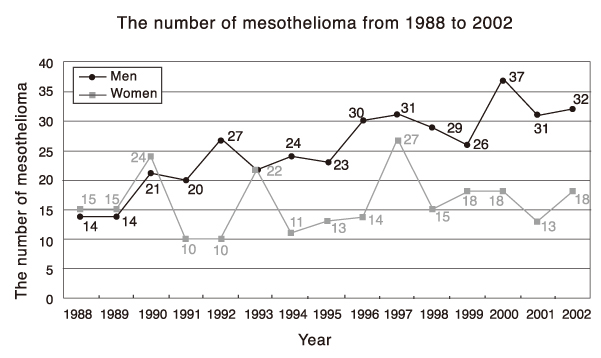Epidemiologic Characteristics of Malignant Mesothelioma in Korea
- Affiliations
-
- 1Department of Preventive Medicine, The Catholic University of Korea College of Medicine, Korea. cyclor@catholic.ac.kr
- 2Department of Occupational Medicine, Dongguk University College of Medicine, Korea. ysahn@dongguk.ac.kr
- 3Department of Pathology, Yonsei University Wonju College of Medicine, Korea. soonheej@yonsei.ac.kr
- KMID: 2188003
- DOI: http://doi.org/10.5124/jkma.2009.52.5.449
Abstract
- Malignant mesothelioma is an aggressive tumor occurring in mesothelial cells of the pleura and peritoneum. This cancer is attributable to asbestos in 80~90% of the patients. Asbestos has been widely used in Korea since the 1970s, therefore, a large number of Korean workers, especially who engaged in the industries of asbestos textiles, shipbuilding, or construction, have been exposed to asbestos occupationally. Korea has several kinds of statistics showing mesothelioma mortality and morbidity, which include cancer registry data, mortality data, and surveillance data. According to the annual report of the Korea Central Cancer Registry (KCCR), fatal malignant mesothelioma occurred in around 40~50 cases a year during the recent 10 years (1993~2002). According to the surveillance data, about 34 cases have been reported annually since 2001. It has also been revealed that about 60% of malignant mesothelioma patients have experiences to be exposed to asbestos in the past. The number of mesothelioma patients in Korea is smaller than that of some developed countries such as United Kingdom, Germany, and Japan. However, mesothelioma has increased greatly in recent years in Korea, and it is expected to increase continuously considering asbestos consumption, as it happened in other countries which used large amounts of asbestos. Therefore, active policies to prevent asbestos-related malignant mesothelioma and to compensate patients suffering from it have to be made in Korea.
Keyword
MeSH Terms
Figure
Cited by 4 articles
-
Overview of Asbestos Issues in Korea
Hyoung Ryoul Kim
J Korean Med Sci. 2009;24(3):363-367. doi: 10.3346/jkms.2009.24.3.363.Radiation-related occupational cancer and its recognition criteria in South Korea
Songwon Seo, Dalnim Lee, Ki Moon Seong, Sunhoo Park, Soo-Geun Kim, Jong-Uk Won, Young Woo Jin
Ann Occup Environ Med. 2018;30(1):. doi: 10.1186/s40557-018-0219-y.The characteristics of asbestos-related disease claims made to the Korea Workers' Compensation and Welfare Service (KCOMWEL) from 2011 to 2015
Yon Soo An, Hyung Doo Kim, Hyeoung Cheol Kim, Kyoung Sook Jeong, Yeon Soon Ahn
Ann Occup Environ Med. 2018;30(1):. doi: 10.1186/s40557-018-0256-6.A Case of Peritoneal Mesothelioma with Direct Invasion to Gastric Mucosa
Seung Min Shin, Sang Man Park, Byung Sik Hwang, Soo Hwan Seol, Hyang Eun Seo, Se Hwan Kim, Mi Jin Gu, Ji Yeol Shin
Korean J Gastroenterol. 2010;56(6):377-381. doi: 10.4166/kjg.2010.56.6.377.
Reference
-
1. McDonald JC, Armstrong BG, Edwards CW, Gibbs AR, Lloyd HM, Pooley FD, Ross DJ, Rudd RM. Case-referent survey of young adults with mesothelioma: I. Lung fibre analyses. Ann Occup Hyg. 2001. 45:513–518.
Article2. Gardner MJ, Saracci R. Effects on health of non-occupational exposure to airborne mineral fibres. IARC Sci Publ. 1989. 90:375.3. Rizzo P, Carbone M, Fisher SG, Matker C, Swinnen LJ, Powers A, Di Resta I, Alkan S, Pass HI, Fisher RI. Simian virus 40 is present in most United States human mesothelioma, but it is rarely present in non-Hodgkin"s ymphoma. Chest. 1999. 116:470–473.4. Anderson HA, Lilis R, Daum SM, Selikoff IJ. Asbestosis among household contacts of asbestos factory workers. Ann N Y Acad Sci. 1979. 330:387–399.
Article5. Choi JK, Paek DM, Paik NW. The production, the use, the number of workers and exposure level of asbestos in Korea. Korean Ind Hyg Assoc J. 1998. 8:242–253. [In Korean].6. Wagner JC, Sleggs CA, Marchad P. Diffuse pleural mesothelioma and asbesos exposure in the North Western Cape Province. Br J Ind Med. 1960. 17:260–271.
Article7. Smith AH, Wright CC. Chrysotile asbestos is the main cause of pleural mesothelioma. Am J Ind Med. 1996. 30:252–266.
Article8. Metintas S, Metintas M, Ucgun I, Oner U. Malignant mesothelioma due to environmental exposure to asbestos: follow-up of a Turkish cohort living in a rural area. Occup Environ Lung Dis. 2002. 122:2224–2229.9. Luo S, Liu X, Mu S, Tsai SP, Wen CP. Asbestos related diseases from environmental exposure to crocidolite in Dayao, China. I. Review of exposure and epidemiological data. Occup Environ Med. 2003. 60:35–41.10. Bianchi C, Bianchi T. Malignant mesothelioma: global incidence and relationship with asbestos. Ind Health. 2007. 45:379–387.
Article11. Lin RT, Takahashi K, Karjalainen A, Hoshuyama T, Wilson D, Kameda T, Chan CC, Wen CP, Furuya S, Higashi T, Chien LC, Ohtaki M. Ecological association between asbestos-related diseases and historical asbestos consumption: an international analysis. Lancet. 2007. 369:844–849.
Article12. Robinson BW, Lake RA. Advances in malignant mesothelioma. N Engl J Med. 2005. 353:1591–1603.
Article13. Jung SH, Kim HR, Koh SB, Yong SJ, Choi BS, Ahn YS, Park TI, Chung MJ, Kim YM, Song JS, chung YK, Myung JP. Epidemiologic characteristics revealed with a malignant mesothelioma surveillance system in Korea. Korean J Occup Environ Med. 2005. 18:46–52. [In Korean].
Article



